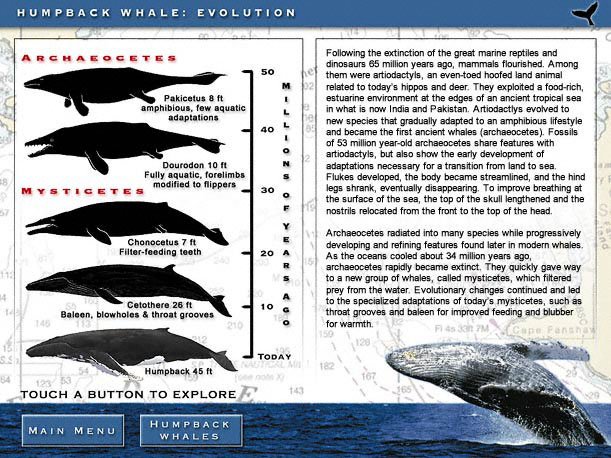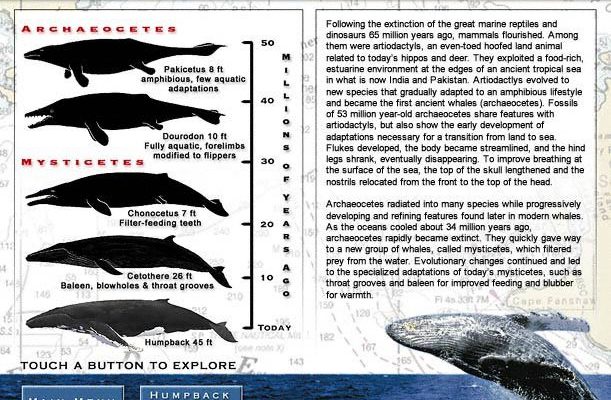
Imagine this: the humpback whale, with all its grace and beauty, is the result of an evolutionary saga that started on land. Yes, you read that right! Their ancestors were once terrestrial animals, resembling modern-day deer or hippos, living in environments we find on land today. As we dive deeper into their story, you’ll see how these creatures transformed into the magnificent marine mammals we know today.
Let’s embark on this journey through time and discover how the humpback whale came to be.
Ancestors on Land: The Origins of Whales
You might be surprised to learn that humpback whales trace their roots back to land-dwelling mammals. Around 50 million years ago, a group of animals known as artiodactyls—think ancestors of pigs, giraffes, and hippos—began to transition to aquatic life. The first significant step in this journey was marked by a creature called Pakicetus, which lived by the water’s edge. These early whales had the basic body shape we associate with marine mammals, but they still needed to breathe air and hunted on land.
Over millions of years, these creatures adapted further. They gradually developed features for life in the water. Their limbs evolved into flippers, and their tails became more powerful, aiding in swimming. Imagine a creature slowly swapping its legs for fins—this was a slow transformation that allowed them to thrive in aquatic environments while still being able to breathe air.
By about 40 million years ago, whales had fully embraced life in the oceans. Ambulocetus, often referred to as the “walking whale,” was a significant milestone in this evolution. It could walk on land but was also an adept swimmer! This dual capability illustrates the transitional phase of their evolution, showing how animals can adapt over time to new environments.
The Evolution of Features: Adaptations to Aquatic Life
As the ancestors of the humpback whale continued to evolve, they developed specialized features that allowed them to thrive in their marine habitat. One of the most notable adaptations was the transformation of their respiratory systems. Over time, whales developed a blowhole—a nostril located on top of their heads—allowing them to breathe without fully surfacing. This change significantly improved their efficiency in the water.
Their bodies also became more streamlined. Picture a torpedo slicing through water—that’s what these creatures evolved into. Their streamlined bodies minimize drag, making swimming effortless. It’s fascinating to think how evolution fine-tunes physical traits like these to enhance survival.
Additionally, humpback whales developed a layer of blubber for insulation. This thick layer of fat not only keeps them warm in frigid waters but also serves as an energy reserve during migration. The humpback is known for its long migrations, traveling thousands of miles between feeding and breeding grounds. This incredible journey is another evolutionary advantage—ensuring their survival and reproduction in various environments.
The Role of Echolocation: Navigating the Oceans
Communication and navigation are crucial for any animal, and humpback whales have developed remarkable features to help them in these areas. Although they don’t rely heavily on echolocation like some other whale species (like dolphins), they can still navigate using a form of *sound communication*. Their songs, which can travel long distances underwater, play a significant role in mating and social interactions.
When a male humpback sings, it’s not just a pretty sound; it serves multiple purposes. The melodies can attract females and establish territory among males. These songs are complex and change over time, showcasing not only their social habits but also the adaptability of their communication methods.
Let’s not forget their incredible hearing abilities. These adaptations allow humpbacks to perceive sounds in the ocean, helping them navigate and find food. Imagine being able to “see” the world through sound—this ability is essential for survival in the vast, often murky depths of the ocean.
Migration Patterns: A Journey Across Oceans
Humpback whales are known for their epic migrations. Every year, they travel thousands of miles from their feeding grounds in colder waters to warmer breeding grounds. This migration isn’t just a casual stroll—it’s a well-timed journey that ensures they find food and suitable conditions for breeding.
During feeding season, humpbacks feast on small fish and krill, building up fat reserves for their long journey. When it comes time to migrate, they head to tropical waters where they mate and give birth. This behavior highlights the importance of their evolutionary path—adapting not just physically but also behaviorally to ensure their survival and reproduction.
Interestingly, the migration of humpbacks isn’t the same for every individual. Some may take a shorter route, while others might travel across entire ocean basins. Scientists believe this flexibility in migration is a strategy honed over generations. It helps ensure that they can find food and breeding opportunities, regardless of changing environmental conditions.
Conservation and Future: Protecting These Majestic Creatures
As we explore the evolutionary journey of the humpback whale, it’s essential to talk about their current status and the challenges they face. Despite their incredible adaptations, human activities have significantly impacted their populations. Whaling, ocean pollution, and climate change have put these magnificent creatures in danger.
Conservation efforts are in place to protect humpback whales, but these efforts require awareness and support. Marine protected areas, stricter fishing regulations, and public education are crucial for ensuring that these animals can continue their journey through the oceans.
Think about it—every time you see a humpback whale breach the surface or hear their haunting songs, you’re witnessing a part of a majestic and lengthy evolutionary story. By supporting conservation initiatives, you can help ensure that future generations experience the beauty and wonder of these incredible animals.
The evolutionary journey of the humpback whale is a testament to the resilience and adaptability of life. From their land-dwelling ancestors to majestic ocean giants, these creatures have faced countless challenges and continue to evolve. Understanding their past helps us appreciate their present and underscores the importance of preserving their future.
As you dive deeper into the world of humpbacks, remember, these whales are much more than just a species—they represent millions of years of evolution, adaptation, and survival. Their story is a powerful reminder of the interconnectedness of life on Earth and our role in protecting it. So next time you see a humpback whale or hear its song, you’ll know there’s much more to appreciate than just its beauty; there’s a whole history behind it.

